Australian Railways: Evaluating Safety and Risk Management
VerifiedAdded on 2023/06/05
|12
|2307
|370
Report
AI Summary
This report examines the increasing train crashes in Australia, focusing on safety and risk management. It investigates a freight train derailment in South Australia and a crash in Sydney, identifying safety breaches and technical faults as primary causes. The report highlights issues such as improper planning, design flaws, and overlooked technical problems. It emphasizes the importance of community protection and adherence to safety regulations like the Rail Safety National Law. The investigation findings reveal that technical faults significantly contributed to the derailment. Recommendations include thorough health check-ups for drivers, comprehensive train inspections, and continuous monitoring from control rooms to enhance railway safety and prevent future incidents. Desklib provides this and other solved assignments for students.
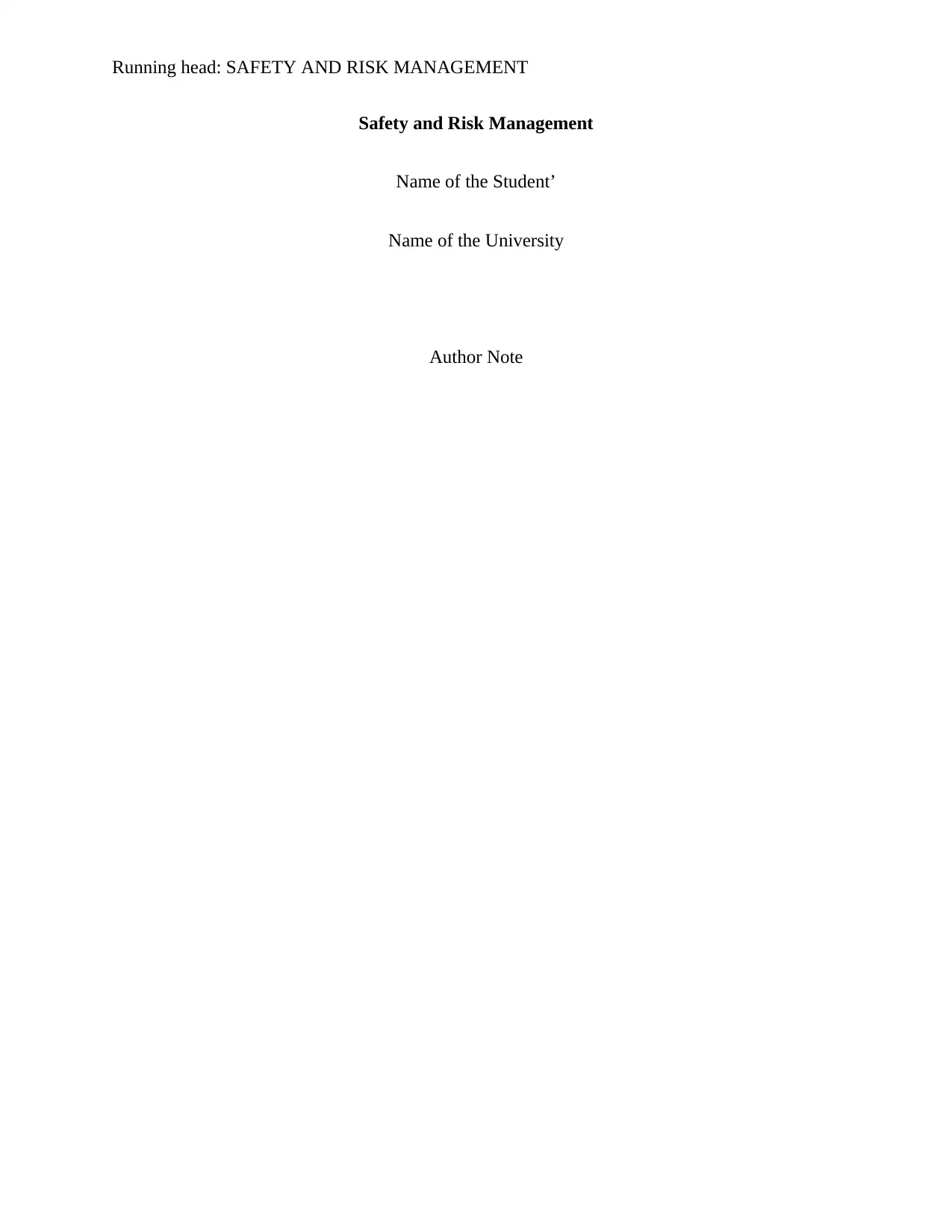
Running head: SAFETY AND RISK MANAGEMENT
Safety and Risk Management
Name of the Student’
Name of the University
Author Note
Safety and Risk Management
Name of the Student’
Name of the University
Author Note
Paraphrase This Document
Need a fresh take? Get an instant paraphrase of this document with our AI Paraphraser

1SAFETY AND RISK MANAGEMENT
Executive summary
Background
The number of the train crashes has increased recently in Australia. The different safety
management plans have not been implied so the lives of the passengers could be saved.
Purpose of the report
The main purpose of the report is to describe the safety and risk management programs could be
managed to provide the best services to keep the passengers safe.
Methods use for the paper
The main problems for the risk and safety management system have been identified. The reasons
for the particular train accident at Sydney and South Australia freight train have been found. The
proper changes in the safety management policies have been recommended for better outcomes.
Key outcomes
It has been found from the research that the technical faults are very much responsible for the
freight train derailment at South Australia. The investigations have revealed it so. Some
important changes in the safety management policies will have to be made.
Executive summary
Background
The number of the train crashes has increased recently in Australia. The different safety
management plans have not been implied so the lives of the passengers could be saved.
Purpose of the report
The main purpose of the report is to describe the safety and risk management programs could be
managed to provide the best services to keep the passengers safe.
Methods use for the paper
The main problems for the risk and safety management system have been identified. The reasons
for the particular train accident at Sydney and South Australia freight train have been found. The
proper changes in the safety management policies have been recommended for better outcomes.
Key outcomes
It has been found from the research that the technical faults are very much responsible for the
freight train derailment at South Australia. The investigations have revealed it so. Some
important changes in the safety management policies will have to be made.
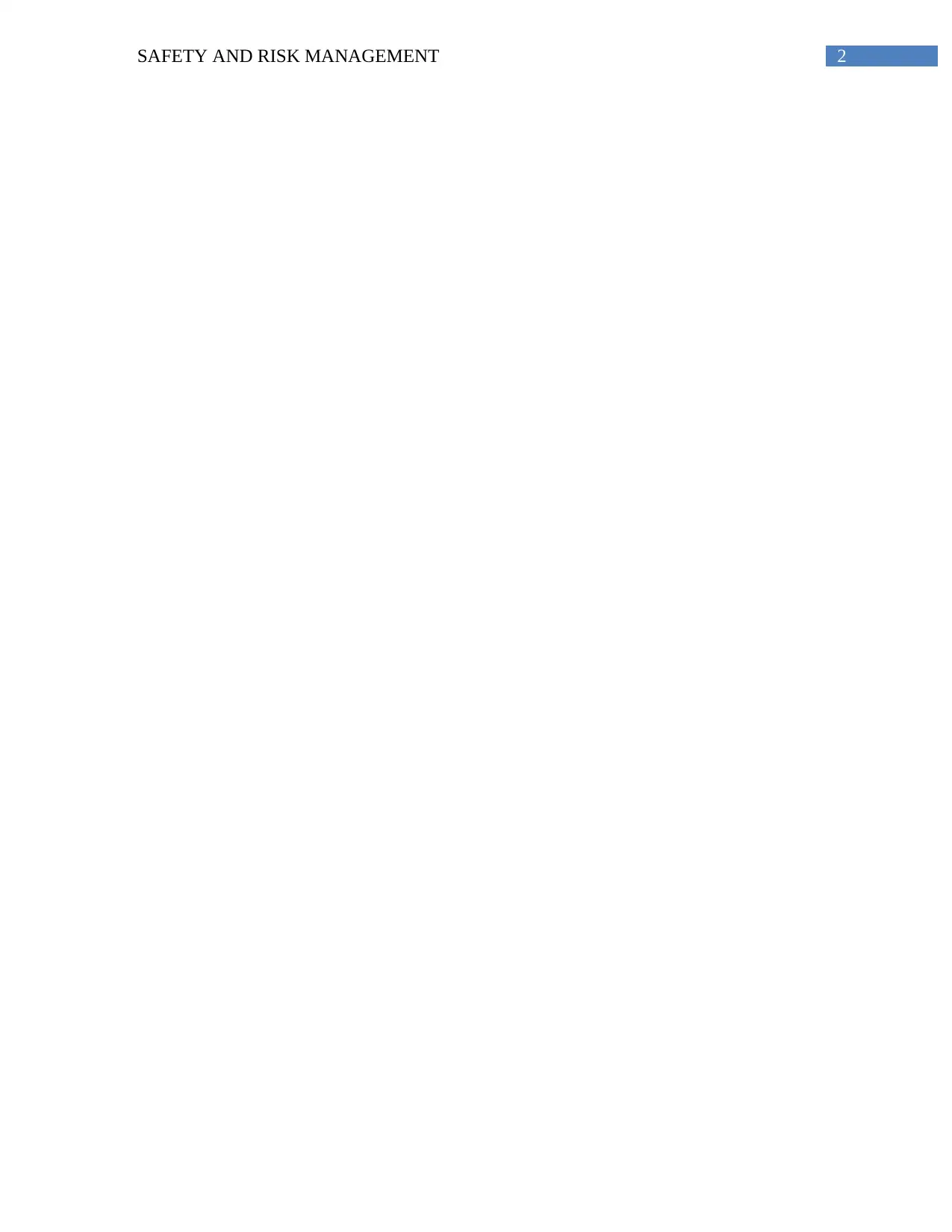
2SAFETY AND RISK MANAGEMENT
⊘ This is a preview!⊘
Do you want full access?
Subscribe today to unlock all pages.

Trusted by 1+ million students worldwide
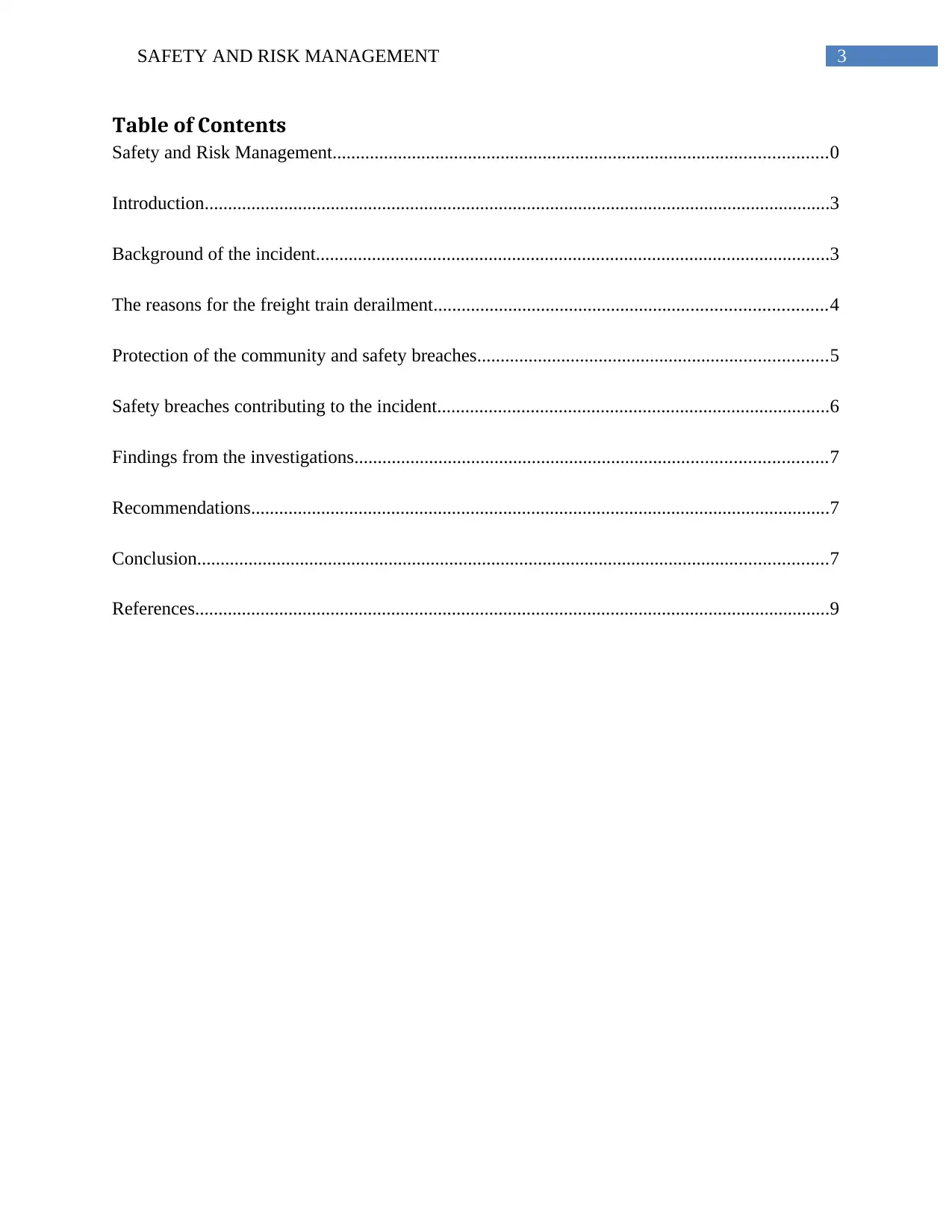
3SAFETY AND RISK MANAGEMENT
Table of Contents
Safety and Risk Management..........................................................................................................0
Introduction......................................................................................................................................3
Background of the incident..............................................................................................................3
The reasons for the freight train derailment....................................................................................4
Protection of the community and safety breaches...........................................................................5
Safety breaches contributing to the incident....................................................................................6
Findings from the investigations.....................................................................................................7
Recommendations............................................................................................................................7
Conclusion.......................................................................................................................................7
References........................................................................................................................................9
Table of Contents
Safety and Risk Management..........................................................................................................0
Introduction......................................................................................................................................3
Background of the incident..............................................................................................................3
The reasons for the freight train derailment....................................................................................4
Protection of the community and safety breaches...........................................................................5
Safety breaches contributing to the incident....................................................................................6
Findings from the investigations.....................................................................................................7
Recommendations............................................................................................................................7
Conclusion.......................................................................................................................................7
References........................................................................................................................................9
Paraphrase This Document
Need a fresh take? Get an instant paraphrase of this document with our AI Paraphraser
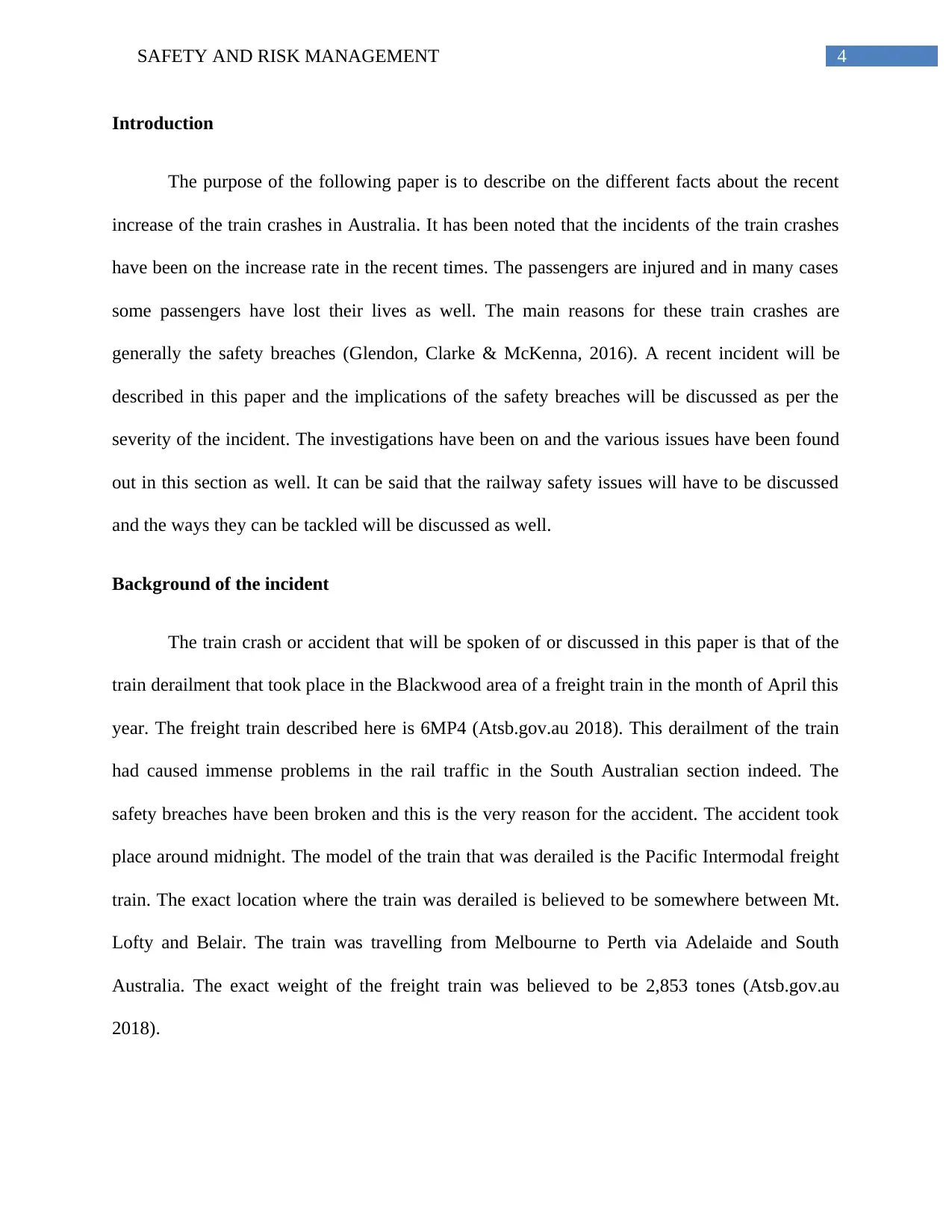
4SAFETY AND RISK MANAGEMENT
Introduction
The purpose of the following paper is to describe on the different facts about the recent
increase of the train crashes in Australia. It has been noted that the incidents of the train crashes
have been on the increase rate in the recent times. The passengers are injured and in many cases
some passengers have lost their lives as well. The main reasons for these train crashes are
generally the safety breaches (Glendon, Clarke & McKenna, 2016). A recent incident will be
described in this paper and the implications of the safety breaches will be discussed as per the
severity of the incident. The investigations have been on and the various issues have been found
out in this section as well. It can be said that the railway safety issues will have to be discussed
and the ways they can be tackled will be discussed as well.
Background of the incident
The train crash or accident that will be spoken of or discussed in this paper is that of the
train derailment that took place in the Blackwood area of a freight train in the month of April this
year. The freight train described here is 6MP4 (Atsb.gov.au 2018). This derailment of the train
had caused immense problems in the rail traffic in the South Australian section indeed. The
safety breaches have been broken and this is the very reason for the accident. The accident took
place around midnight. The model of the train that was derailed is the Pacific Intermodal freight
train. The exact location where the train was derailed is believed to be somewhere between Mt.
Lofty and Belair. The train was travelling from Melbourne to Perth via Adelaide and South
Australia. The exact weight of the freight train was believed to be 2,853 tones (Atsb.gov.au
2018).
Introduction
The purpose of the following paper is to describe on the different facts about the recent
increase of the train crashes in Australia. It has been noted that the incidents of the train crashes
have been on the increase rate in the recent times. The passengers are injured and in many cases
some passengers have lost their lives as well. The main reasons for these train crashes are
generally the safety breaches (Glendon, Clarke & McKenna, 2016). A recent incident will be
described in this paper and the implications of the safety breaches will be discussed as per the
severity of the incident. The investigations have been on and the various issues have been found
out in this section as well. It can be said that the railway safety issues will have to be discussed
and the ways they can be tackled will be discussed as well.
Background of the incident
The train crash or accident that will be spoken of or discussed in this paper is that of the
train derailment that took place in the Blackwood area of a freight train in the month of April this
year. The freight train described here is 6MP4 (Atsb.gov.au 2018). This derailment of the train
had caused immense problems in the rail traffic in the South Australian section indeed. The
safety breaches have been broken and this is the very reason for the accident. The accident took
place around midnight. The model of the train that was derailed is the Pacific Intermodal freight
train. The exact location where the train was derailed is believed to be somewhere between Mt.
Lofty and Belair. The train was travelling from Melbourne to Perth via Adelaide and South
Australia. The exact weight of the freight train was believed to be 2,853 tones (Atsb.gov.au
2018).
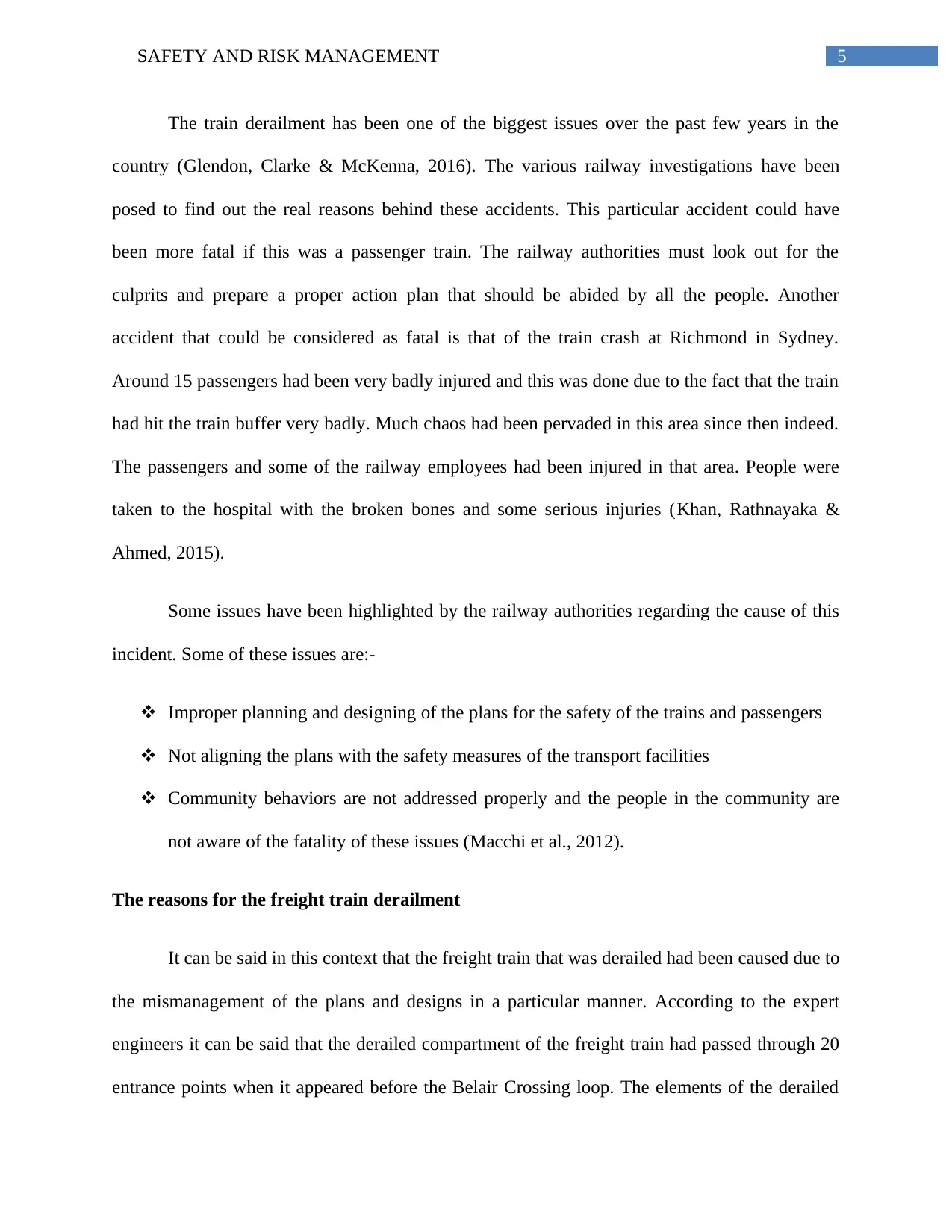
5SAFETY AND RISK MANAGEMENT
The train derailment has been one of the biggest issues over the past few years in the
country (Glendon, Clarke & McKenna, 2016). The various railway investigations have been
posed to find out the real reasons behind these accidents. This particular accident could have
been more fatal if this was a passenger train. The railway authorities must look out for the
culprits and prepare a proper action plan that should be abided by all the people. Another
accident that could be considered as fatal is that of the train crash at Richmond in Sydney.
Around 15 passengers had been very badly injured and this was done due to the fact that the train
had hit the train buffer very badly. Much chaos had been pervaded in this area since then indeed.
The passengers and some of the railway employees had been injured in that area. People were
taken to the hospital with the broken bones and some serious injuries (Khan, Rathnayaka &
Ahmed, 2015).
Some issues have been highlighted by the railway authorities regarding the cause of this
incident. Some of these issues are:-
Improper planning and designing of the plans for the safety of the trains and passengers
Not aligning the plans with the safety measures of the transport facilities
Community behaviors are not addressed properly and the people in the community are
not aware of the fatality of these issues (Macchi et al., 2012).
The reasons for the freight train derailment
It can be said in this context that the freight train that was derailed had been caused due to
the mismanagement of the plans and designs in a particular manner. According to the expert
engineers it can be said that the derailed compartment of the freight train had passed through 20
entrance points when it appeared before the Belair Crossing loop. The elements of the derailed
The train derailment has been one of the biggest issues over the past few years in the
country (Glendon, Clarke & McKenna, 2016). The various railway investigations have been
posed to find out the real reasons behind these accidents. This particular accident could have
been more fatal if this was a passenger train. The railway authorities must look out for the
culprits and prepare a proper action plan that should be abided by all the people. Another
accident that could be considered as fatal is that of the train crash at Richmond in Sydney.
Around 15 passengers had been very badly injured and this was done due to the fact that the train
had hit the train buffer very badly. Much chaos had been pervaded in this area since then indeed.
The passengers and some of the railway employees had been injured in that area. People were
taken to the hospital with the broken bones and some serious injuries (Khan, Rathnayaka &
Ahmed, 2015).
Some issues have been highlighted by the railway authorities regarding the cause of this
incident. Some of these issues are:-
Improper planning and designing of the plans for the safety of the trains and passengers
Not aligning the plans with the safety measures of the transport facilities
Community behaviors are not addressed properly and the people in the community are
not aware of the fatality of these issues (Macchi et al., 2012).
The reasons for the freight train derailment
It can be said in this context that the freight train that was derailed had been caused due to
the mismanagement of the plans and designs in a particular manner. According to the expert
engineers it can be said that the derailed compartment of the freight train had passed through 20
entrance points when it appeared before the Belair Crossing loop. The elements of the derailed
⊘ This is a preview!⊘
Do you want full access?
Subscribe today to unlock all pages.

Trusted by 1+ million students worldwide
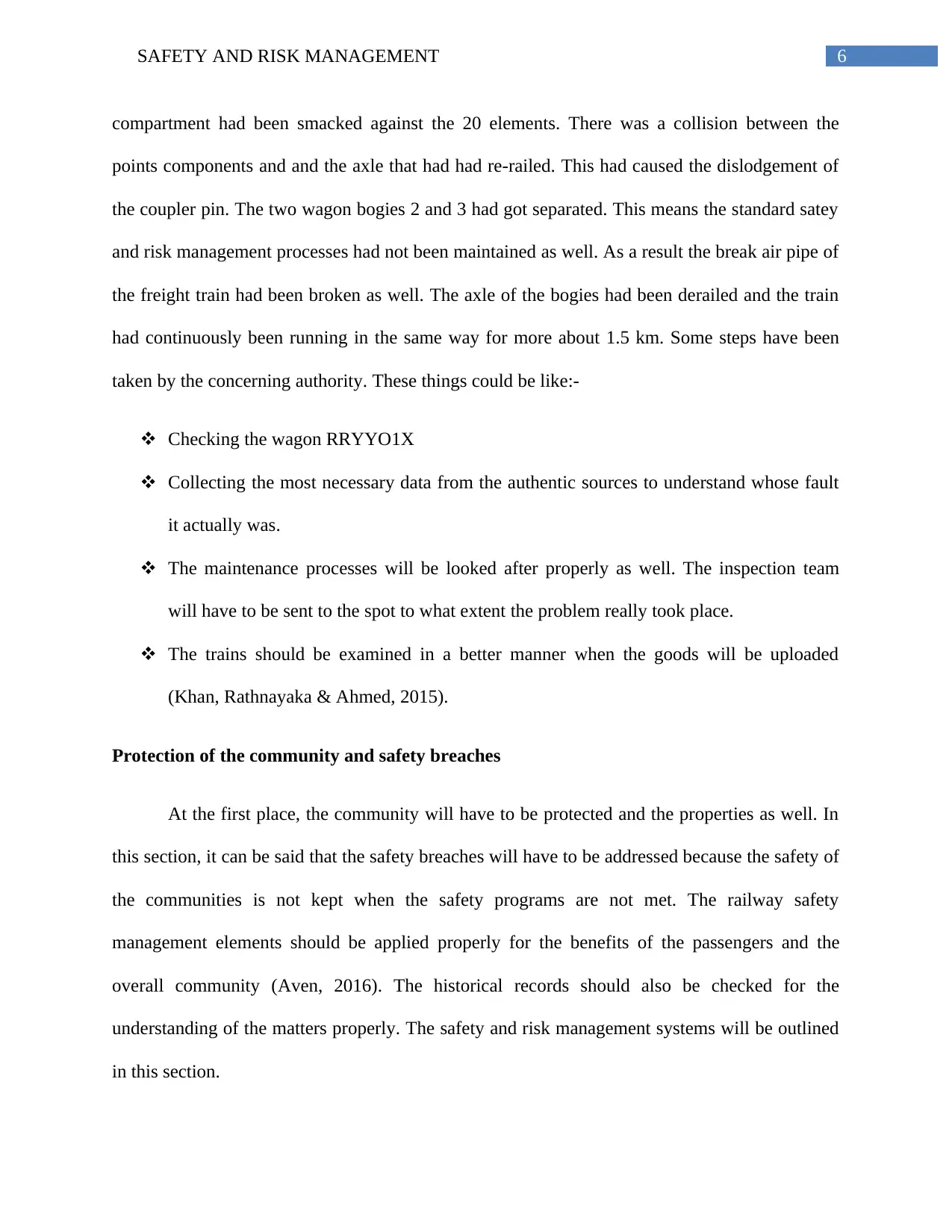
6SAFETY AND RISK MANAGEMENT
compartment had been smacked against the 20 elements. There was a collision between the
points components and and the axle that had had re-railed. This had caused the dislodgement of
the coupler pin. The two wagon bogies 2 and 3 had got separated. This means the standard satey
and risk management processes had not been maintained as well. As a result the break air pipe of
the freight train had been broken as well. The axle of the bogies had been derailed and the train
had continuously been running in the same way for more about 1.5 km. Some steps have been
taken by the concerning authority. These things could be like:-
Checking the wagon RRYYO1X
Collecting the most necessary data from the authentic sources to understand whose fault
it actually was.
The maintenance processes will be looked after properly as well. The inspection team
will have to be sent to the spot to what extent the problem really took place.
The trains should be examined in a better manner when the goods will be uploaded
(Khan, Rathnayaka & Ahmed, 2015).
Protection of the community and safety breaches
At the first place, the community will have to be protected and the properties as well. In
this section, it can be said that the safety breaches will have to be addressed because the safety of
the communities is not kept when the safety programs are not met. The railway safety
management elements should be applied properly for the benefits of the passengers and the
overall community (Aven, 2016). The historical records should also be checked for the
understanding of the matters properly. The safety and risk management systems will be outlined
in this section.
compartment had been smacked against the 20 elements. There was a collision between the
points components and and the axle that had had re-railed. This had caused the dislodgement of
the coupler pin. The two wagon bogies 2 and 3 had got separated. This means the standard satey
and risk management processes had not been maintained as well. As a result the break air pipe of
the freight train had been broken as well. The axle of the bogies had been derailed and the train
had continuously been running in the same way for more about 1.5 km. Some steps have been
taken by the concerning authority. These things could be like:-
Checking the wagon RRYYO1X
Collecting the most necessary data from the authentic sources to understand whose fault
it actually was.
The maintenance processes will be looked after properly as well. The inspection team
will have to be sent to the spot to what extent the problem really took place.
The trains should be examined in a better manner when the goods will be uploaded
(Khan, Rathnayaka & Ahmed, 2015).
Protection of the community and safety breaches
At the first place, the community will have to be protected and the properties as well. In
this section, it can be said that the safety breaches will have to be addressed because the safety of
the communities is not kept when the safety programs are not met. The railway safety
management elements should be applied properly for the benefits of the passengers and the
overall community (Aven, 2016). The historical records should also be checked for the
understanding of the matters properly. The safety and risk management systems will be outlined
in this section.
Paraphrase This Document
Need a fresh take? Get an instant paraphrase of this document with our AI Paraphraser
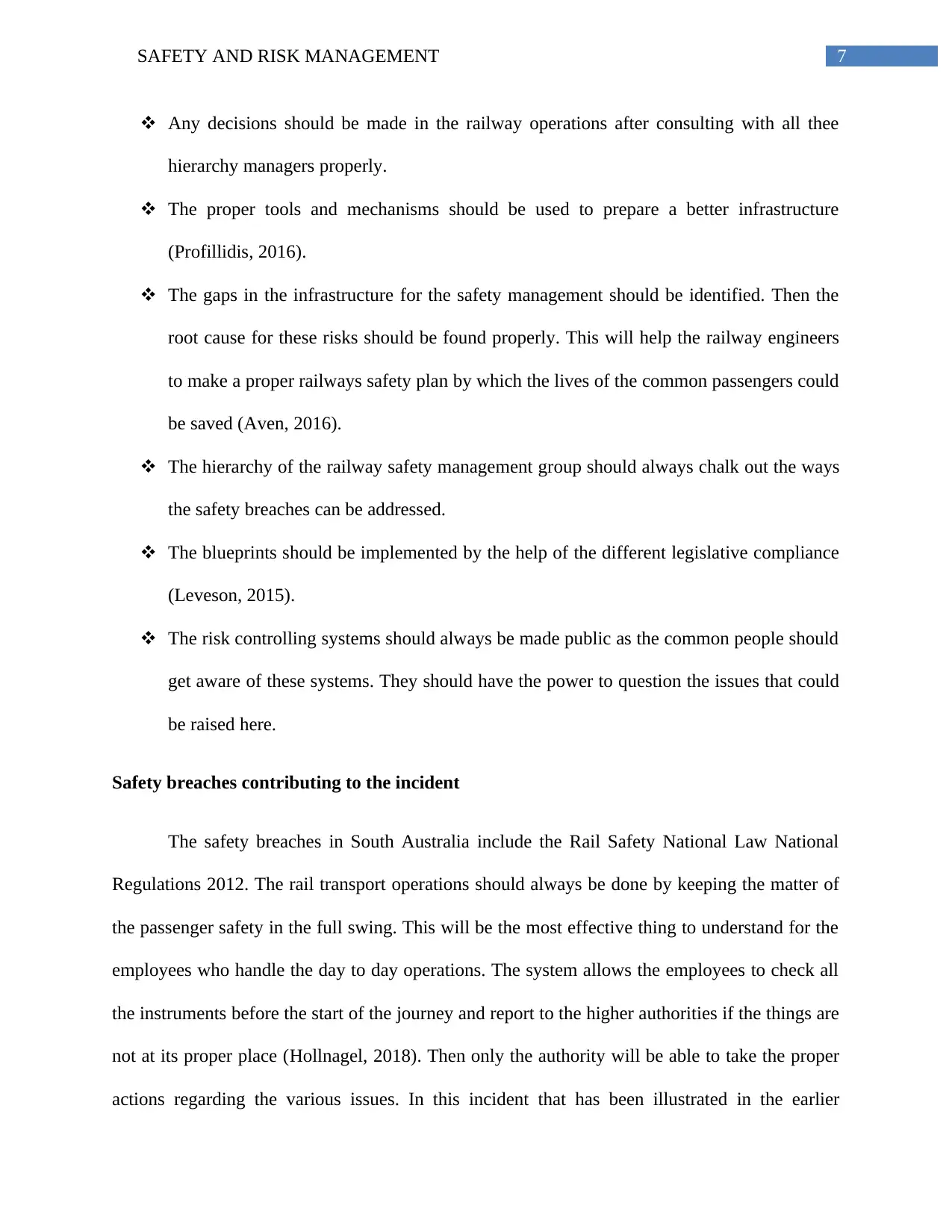
7SAFETY AND RISK MANAGEMENT
Any decisions should be made in the railway operations after consulting with all thee
hierarchy managers properly.
The proper tools and mechanisms should be used to prepare a better infrastructure
(Profillidis, 2016).
The gaps in the infrastructure for the safety management should be identified. Then the
root cause for these risks should be found properly. This will help the railway engineers
to make a proper railways safety plan by which the lives of the common passengers could
be saved (Aven, 2016).
The hierarchy of the railway safety management group should always chalk out the ways
the safety breaches can be addressed.
The blueprints should be implemented by the help of the different legislative compliance
(Leveson, 2015).
The risk controlling systems should always be made public as the common people should
get aware of these systems. They should have the power to question the issues that could
be raised here.
Safety breaches contributing to the incident
The safety breaches in South Australia include the Rail Safety National Law National
Regulations 2012. The rail transport operations should always be done by keeping the matter of
the passenger safety in the full swing. This will be the most effective thing to understand for the
employees who handle the day to day operations. The system allows the employees to check all
the instruments before the start of the journey and report to the higher authorities if the things are
not at its proper place (Hollnagel, 2018). Then only the authority will be able to take the proper
actions regarding the various issues. In this incident that has been illustrated in the earlier
Any decisions should be made in the railway operations after consulting with all thee
hierarchy managers properly.
The proper tools and mechanisms should be used to prepare a better infrastructure
(Profillidis, 2016).
The gaps in the infrastructure for the safety management should be identified. Then the
root cause for these risks should be found properly. This will help the railway engineers
to make a proper railways safety plan by which the lives of the common passengers could
be saved (Aven, 2016).
The hierarchy of the railway safety management group should always chalk out the ways
the safety breaches can be addressed.
The blueprints should be implemented by the help of the different legislative compliance
(Leveson, 2015).
The risk controlling systems should always be made public as the common people should
get aware of these systems. They should have the power to question the issues that could
be raised here.
Safety breaches contributing to the incident
The safety breaches in South Australia include the Rail Safety National Law National
Regulations 2012. The rail transport operations should always be done by keeping the matter of
the passenger safety in the full swing. This will be the most effective thing to understand for the
employees who handle the day to day operations. The system allows the employees to check all
the instruments before the start of the journey and report to the higher authorities if the things are
not at its proper place (Hollnagel, 2018). Then only the authority will be able to take the proper
actions regarding the various issues. In this incident that has been illustrated in the earlier
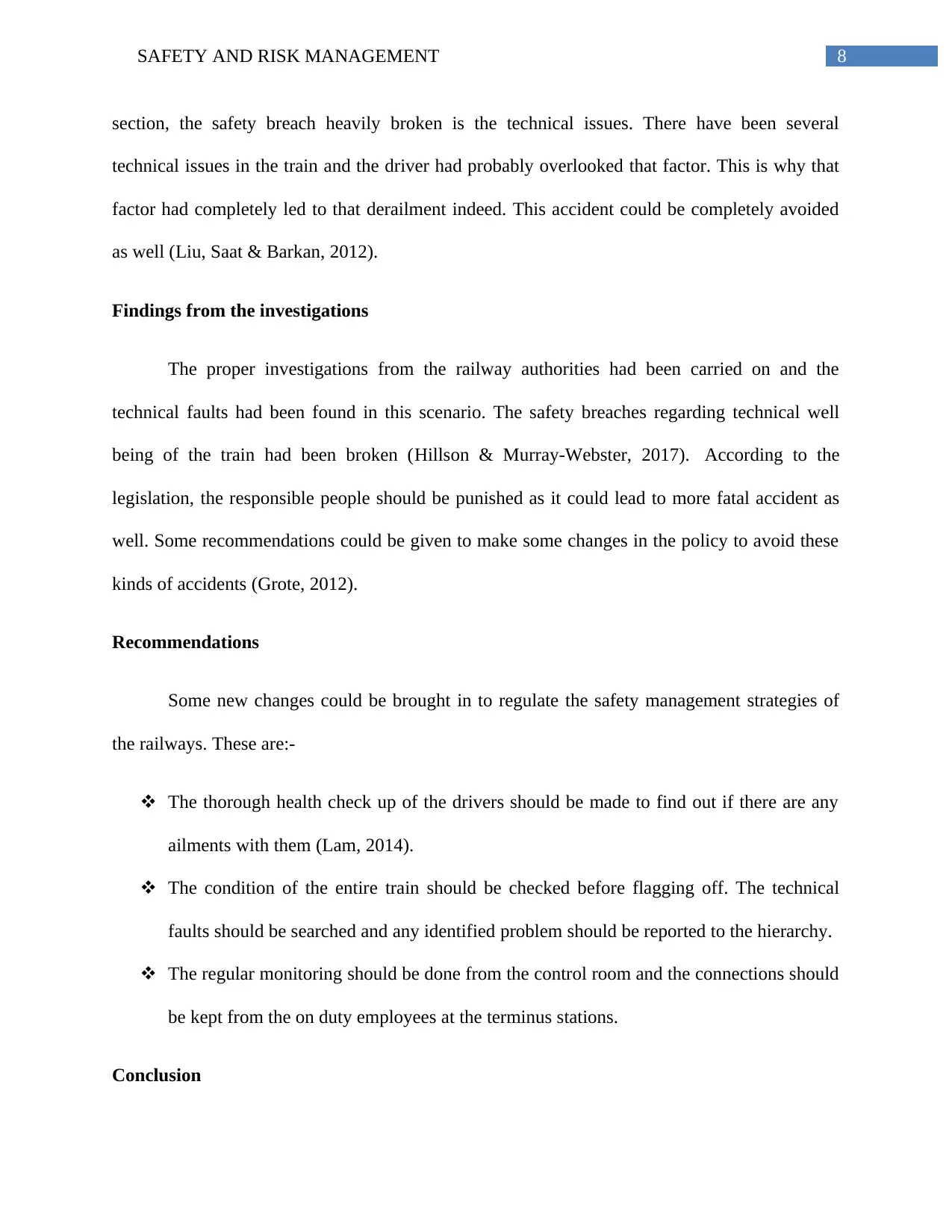
8SAFETY AND RISK MANAGEMENT
section, the safety breach heavily broken is the technical issues. There have been several
technical issues in the train and the driver had probably overlooked that factor. This is why that
factor had completely led to that derailment indeed. This accident could be completely avoided
as well (Liu, Saat & Barkan, 2012).
Findings from the investigations
The proper investigations from the railway authorities had been carried on and the
technical faults had been found in this scenario. The safety breaches regarding technical well
being of the train had been broken (Hillson & Murray-Webster, 2017). According to the
legislation, the responsible people should be punished as it could lead to more fatal accident as
well. Some recommendations could be given to make some changes in the policy to avoid these
kinds of accidents (Grote, 2012).
Recommendations
Some new changes could be brought in to regulate the safety management strategies of
the railways. These are:-
The thorough health check up of the drivers should be made to find out if there are any
ailments with them (Lam, 2014).
The condition of the entire train should be checked before flagging off. The technical
faults should be searched and any identified problem should be reported to the hierarchy.
The regular monitoring should be done from the control room and the connections should
be kept from the on duty employees at the terminus stations.
Conclusion
section, the safety breach heavily broken is the technical issues. There have been several
technical issues in the train and the driver had probably overlooked that factor. This is why that
factor had completely led to that derailment indeed. This accident could be completely avoided
as well (Liu, Saat & Barkan, 2012).
Findings from the investigations
The proper investigations from the railway authorities had been carried on and the
technical faults had been found in this scenario. The safety breaches regarding technical well
being of the train had been broken (Hillson & Murray-Webster, 2017). According to the
legislation, the responsible people should be punished as it could lead to more fatal accident as
well. Some recommendations could be given to make some changes in the policy to avoid these
kinds of accidents (Grote, 2012).
Recommendations
Some new changes could be brought in to regulate the safety management strategies of
the railways. These are:-
The thorough health check up of the drivers should be made to find out if there are any
ailments with them (Lam, 2014).
The condition of the entire train should be checked before flagging off. The technical
faults should be searched and any identified problem should be reported to the hierarchy.
The regular monitoring should be done from the control room and the connections should
be kept from the on duty employees at the terminus stations.
Conclusion
⊘ This is a preview!⊘
Do you want full access?
Subscribe today to unlock all pages.

Trusted by 1+ million students worldwide

9SAFETY AND RISK MANAGEMENT
As per the above discussion, it can be concluded that an incident of a particular train
crash has been discussed here. The derailment of the freight train and the train crash at
Richmond near Sydney has been discussed here. The probable safety breaches have been
highlighted. These safety breaches can be very much fatal for the overall security of the
passengers and the goods. Some recommendations have been given as to how to change the
policies and make the safety management system in a better manner. Thus the better outcomes
could be expected. The lives of the daily commuters should be given the most priority.
As per the above discussion, it can be concluded that an incident of a particular train
crash has been discussed here. The derailment of the freight train and the train crash at
Richmond near Sydney has been discussed here. The probable safety breaches have been
highlighted. These safety breaches can be very much fatal for the overall security of the
passengers and the goods. Some recommendations have been given as to how to change the
policies and make the safety management system in a better manner. Thus the better outcomes
could be expected. The lives of the daily commuters should be given the most priority.
Paraphrase This Document
Need a fresh take? Get an instant paraphrase of this document with our AI Paraphraser

10SAFETY AND RISK MANAGEMENT
References
Atsb.gov.au. (2018). Investigation: RO-2018-009 - Derailment of freight train 6MP4 near
Glenalta, South Australia on 21 April 2018. Retrieved from
https://www.atsb.gov.au/publications/investigation_reports/2018/rair/ro-2018-009/
Aven, T. (2016). Risk assessment and risk management: Review of recent advances on their
foundation. European Journal of Operational Research, 253(1), 1-13.
Glendon, A. I., Clarke, S., & McKenna, E. (2016). Human safety and risk management. Crc
Press.
Grote, G. (2012). Safety management in different high-risk domains–all the same?. Safety
Science, 50(10), 1983-1992.
Hillson, D., & Murray-Webster, R. (2017). Understanding and managing risk attitude.
Routledge.
Hollnagel, E. (2018). Safety-I and Safety-II: the past and future of safety management. CRC
Press.
Khan, F., Rathnayaka, S., & Ahmed, S. (2015). Methods and models in process safety and risk
management: Past, present and future. Process Safety and Environmental Protection, 98,
116-147.
Lam, J. (2014). Enterprise risk management: from incentives to controls. John Wiley & Sons.
Leveson, N. (2015). A systems approach to risk management through leading safety
indicators. Reliability Engineering & System Safety, 136, 17-34.
References
Atsb.gov.au. (2018). Investigation: RO-2018-009 - Derailment of freight train 6MP4 near
Glenalta, South Australia on 21 April 2018. Retrieved from
https://www.atsb.gov.au/publications/investigation_reports/2018/rair/ro-2018-009/
Aven, T. (2016). Risk assessment and risk management: Review of recent advances on their
foundation. European Journal of Operational Research, 253(1), 1-13.
Glendon, A. I., Clarke, S., & McKenna, E. (2016). Human safety and risk management. Crc
Press.
Grote, G. (2012). Safety management in different high-risk domains–all the same?. Safety
Science, 50(10), 1983-1992.
Hillson, D., & Murray-Webster, R. (2017). Understanding and managing risk attitude.
Routledge.
Hollnagel, E. (2018). Safety-I and Safety-II: the past and future of safety management. CRC
Press.
Khan, F., Rathnayaka, S., & Ahmed, S. (2015). Methods and models in process safety and risk
management: Past, present and future. Process Safety and Environmental Protection, 98,
116-147.
Lam, J. (2014). Enterprise risk management: from incentives to controls. John Wiley & Sons.
Leveson, N. (2015). A systems approach to risk management through leading safety
indicators. Reliability Engineering & System Safety, 136, 17-34.
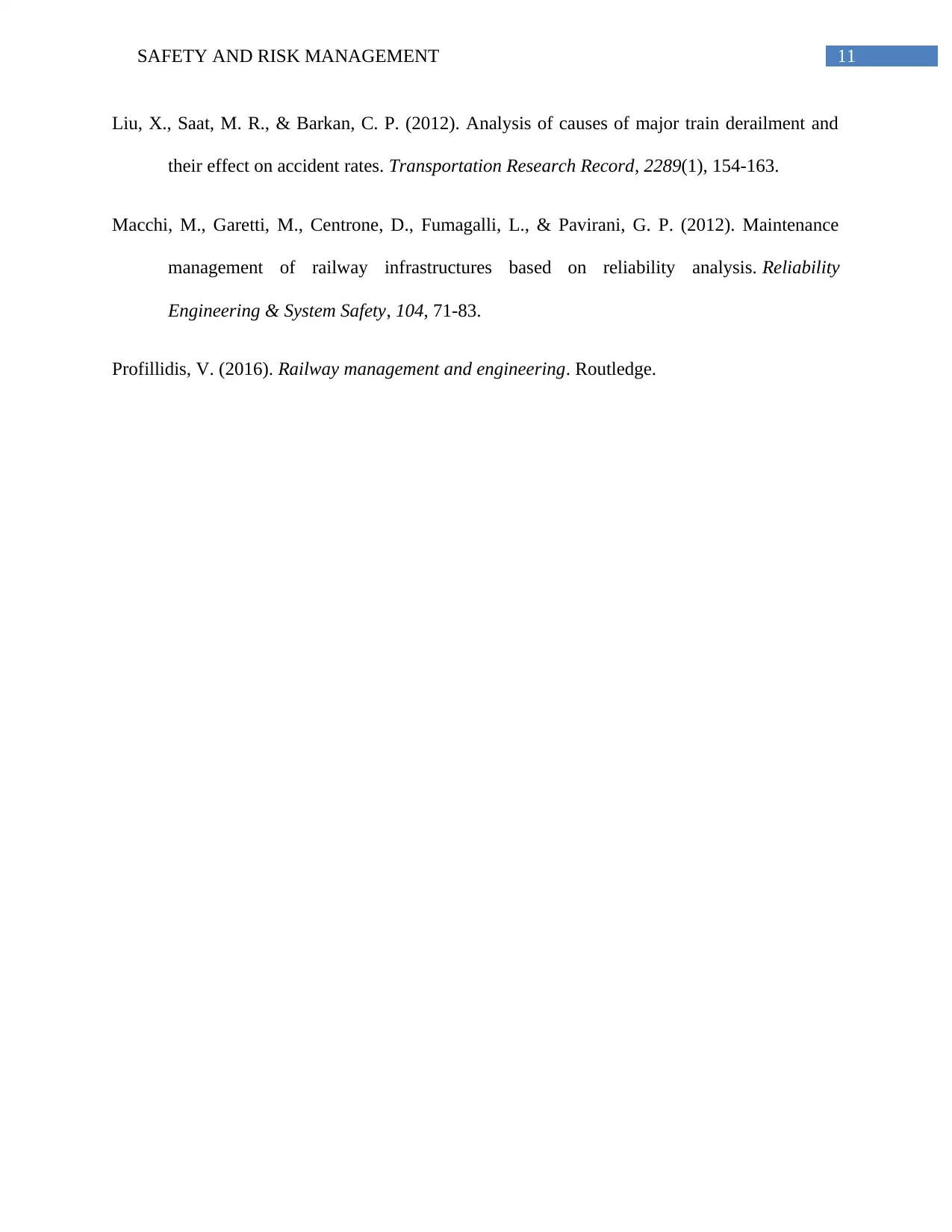
11SAFETY AND RISK MANAGEMENT
Liu, X., Saat, M. R., & Barkan, C. P. (2012). Analysis of causes of major train derailment and
their effect on accident rates. Transportation Research Record, 2289(1), 154-163.
Macchi, M., Garetti, M., Centrone, D., Fumagalli, L., & Pavirani, G. P. (2012). Maintenance
management of railway infrastructures based on reliability analysis. Reliability
Engineering & System Safety, 104, 71-83.
Profillidis, V. (2016). Railway management and engineering. Routledge.
Liu, X., Saat, M. R., & Barkan, C. P. (2012). Analysis of causes of major train derailment and
their effect on accident rates. Transportation Research Record, 2289(1), 154-163.
Macchi, M., Garetti, M., Centrone, D., Fumagalli, L., & Pavirani, G. P. (2012). Maintenance
management of railway infrastructures based on reliability analysis. Reliability
Engineering & System Safety, 104, 71-83.
Profillidis, V. (2016). Railway management and engineering. Routledge.
⊘ This is a preview!⊘
Do you want full access?
Subscribe today to unlock all pages.

Trusted by 1+ million students worldwide
1 out of 12
Related Documents
Your All-in-One AI-Powered Toolkit for Academic Success.
+13062052269
info@desklib.com
Available 24*7 on WhatsApp / Email
![[object Object]](/_next/static/media/star-bottom.7253800d.svg)
Unlock your academic potential
Copyright © 2020–2025 A2Z Services. All Rights Reserved. Developed and managed by ZUCOL.





